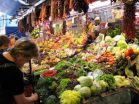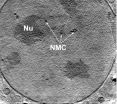(Press-News.org) Eating five portions of fruit and vegetables per day is one of the means that experts most frequently recommend for preventing cancer. Now, the European EPIC study carried out by researchers from 10 countries has shown that, in the case of lung cancer, the important thing is not just the quantity but also the variety of fruit consumed, which can reduce the risk by up to 23%.
"This research looks more deeply into the relationship between diet and lung cancer", María José Sánchez Pérez, co-author of the study and director of the Granada Cancer Registry at the Andalusian School of Public Health, tells SINC.
She says: "Aside from the amount consumed, it's also important to take into account the variety. A varied diet reduces the risk of developing this cancer, above all in smokers".
The results of this study, which have been published in the journal Cancer Epidemiology, Biomarkers & Prevention, show that eating "more than eight sub-groups" of vegetables cuts this risk by 23% compared with eating "less than four sub-groups". In addition, this risk falls by a further 4% for each unit added to the diet from another sub-group.
"A significant link was only found in smokers", the researcher stresses. "For every two additional units of different kinds of fruits and vegetables in the diet, the risk of lung cancer falls significantly by 3%. So if smokers increase the variety of fruit they eat they could have a lower risk of developing this type of cancer".
The European Prospective Investigation into Cancer and Nutrition (EPIC) involves 23 centres from 10 European countries (Germany, Denmark, Spain, France, Greece, Holland, Italy, Norway, the United Kingdom and Sweden, working with a sample of 500,000 European subjects (41,000 of whom live in the Spanish regions of Asturias, Granada, Guipúzcoa, Murcia and Navarre).
Lung cancer continues to be one of the most common cancers in developed countries. For this reason, despite the encouraging results of this study, Sánchez Pérez concludes that "the most effective way of preventing it continues to be reducing the prevalence of tobacco consumption among the populace".
The effect by type of cancerous tissue
Greater variety in fruit and vegetable consumption is associated with a lower risk of developing epidermoid carcinoma of the lung, with an additional two units of fruit and vegetable consumption leading to a 9% reduction in risk. This effect is clearer among smokers (where the risk falls by 12%).
No significant association between fruit and vegetable consumption and the risk of developing lung cancer was seen for the other kinds of tissues affected (adenocarcinoma and small and large cell carcinoma).
INFORMATION:
References:
Frederike L. Büchner, H. Bas Bueno-de-Mesquita, Martine M. Ros, Kim Overvad, Christina C. Dahm, Louise Hansen, Anne Tjønneland, Françoise Clavel-Chapelon, Marie-Christine Boutron-Ruault, Marina Touillaud, Rudolf Kaaks, Sabine Rohrmann, Heiner Boeing, Ute Nöthlings, Antonia Trichopoulou, Dimosthenis Zylis, Vardis Dilis, Domenico Palli, Sabina Sieri, Paolo Vineis, Rosario Tumino, Salvatore Panico, Petra H.M. Peeters, Carla H. van Gils, Eiliv Lund, Inger T. Gram, Tonje Braaten, María-José Sánchez, Antonio Agudo, Nerea Larrañaga, Eva Ardanaz, Carmen Navarro, Marcial V. Argüelles, Jonas Manjer, Elisabet Wirfält, Göran Hallmans, Torgny Rasmuson, Tim J. Key, Kay-Tee Khaw, Nick Wareham, Nadia Slimani, Anne-Claire Vergnaud, Wei W. Xun, Lambertus A.L.M. Kiemeney, and Elio Riboli. "La variedad en el consumo de frutas y verduras disminuye el riesgo de desarrollar cáncer de pulmón entre las personas fumadoras". Cancer Epidemiol Biomarkers Prev; 19(9); 2278 septiembre de 2010.
Eating a variety of fruit cuts lung cancer risk
2010-11-20
ELSE PRESS RELEASES FROM THIS DATE:
Special section on ecological distribution conflicts in the journal Ecological Economics
2010-11-20
Researchers from Institute of Environmental Science and Technology (ICTA), at Universitat Autònoma de Barcelona (UAB), and other universities have published a special section in the journal Ecological Economics that analyzes the link between ecological economics and political ecology. This issue stems from the institute's research on impacts and resistance at the "commodity frontiers", where the extraction of natural resources and the disposal of toxic wastes produce a range of economic, environmental, cultural and social conflicts.
The special issue, titled Social Metabolism, ...
Online map of maternal health to inform world leaders
2010-11-20
Researchers from the University of Southampton have helped construct an online interactive world map which gives stark facts and figures about the health of women during pregnancy, childbirth and following the birth of their child.
Social scientists Professor Zoë Matthews and Dr Sarah Neal are working in collaboration with the White Ribbon Alliance for Safe Motherhood and the University of Aberdeen on a joint project worth in excess of £160,000 called 'The Atlas of Birth', which also includes a book, short film and flyers.
"We are using data from the United Nations ...
New microscope reveals ultrastructure of cells
2010-11-20
For the first time, there is no need to chemically fix, stain or cut cells in order to study them. Instead, whole living cells are fast-frozen and studied in their natural environment. The new method delivers an immediate 3-D image, thereby closing a gap between conventional microscopic techniques.
The new microscope delivers a high-resolution 3-D image of the entire cell in one step. This is an advantage over electron microscopy, in which a 3-D image is assembled out of many thin sections. This can take up to weeks for just one cell. Also, the cell need not be labelled ...
Gene links to anorexia found by Children's Hospital of Philadelphia researchers
2010-11-20
Scientists at The Children's Hospital of Philadelphia have identified both common and rare gene variants associated with the eating disorder anorexia nervosa. In the largest genetic study of this psychiatric disorder, the researchers found intriguing clues to genes they are subjecting to further investigation, including genes active in neuronal signaling and in shaping interconnections among brain cells.
Anorexia nervosa (AN) affects an estimated 9 in 1000 women in the United States. Patients have food refusal, weight loss, an irrational fear of weight gain even when ...
Designing more effective anti-HIV antibodies
2010-11-20
Boston, Mass. – Although people infected with HIV produce many antibodies against the protein encapsulating the virus, most of these antibodies are strangely ineffective at fighting the disease. A new study suggests why some of the most common of these antibodies don't work: they target the protein in a form it takes after the virus has already invaded the cell, when it's too late, report researchers at Children's Hospital Boston and their colleagues.
The findings, published online Nov. 14 in the journal Nature Structural & Molecular Biology, refocus attention on the ...
Professor Zvi Ram presents phase III recurrent glioblastoma survival and quality of life data from the first pivotal study of the NovoTTF-100A at 15th Annual Society for Neuro-Oncology Scientific Meet
2010-11-20
MONTREAL, CANADA - November 19, 2010 - Data presented today from a pivotal, phase III randomized clinical trial for patients with recurrent glioblastoma tumors suggest that Tumor Treating Fields (TTF) therapy may increase median survival time and improve quality of life scores compared to best standard of care chemotherapy. Professor Zvi Ram, chairman of the Department of Neurosurgery at Tel-Aviv Sourasky Medical Center, presented the data at the Society for Neuro-Oncology (SNO) Annual Scientific Meeting.
Physicians delivered the investigational TTF therapy to patients ...
Childhood obesity linked to increased risk of adult cardiovascular and metabolic disorders
2010-11-20
New Rochelle, NY, November 19, 2010—Mounting evidence linking childhood obesity to an increasing risk of obesity, heart disease, type 2 diabetes, and other cardiovascular and metabolic disorders in adulthood is clearly presented in a comprehensive review article in the current issue of Childhood Obesity, published by Mary Ann Liebert, Inc. The article is available free online.
Authors Megan Moriarty-Kelsey, MD and Stephen Daniels, MD, PhD, Department of Pediatrics, University of Colorado School of Medicine, caution that the rising prevalence of obesity in children will ...
New path for colon cancer drug discovery
2010-11-20
An old pinworm medicine is a new lead in the search for compounds that block a signaling pathway implicated in colon cancer. The findings, reported by Vanderbilt University Medical Center researchers in the November issue of Nature Chemical Biology, suggest a fresh approach for developing therapeutics that target the pathway.
More than 90 percent of sporadic (non-inherited) colon cancers – the second deadliest type of cancer in the developed world – are caused by mutations that result in inappropriate activation of the Wnt (pronounced "wint") signaling pathway. Blocking ...
Scripps Research scientists identify first synthetic activator of 2 critical proteins
2010-11-20
JUPITER, FL, November 19, 2010 – Scientists from the Florida campus of The Scripps Research Institute have identified a novel synthetic activator of a pair of proteins that belong to a protein family playing key roles in human metabolism and immune function. The discovery could provide new and potentially more effective therapeutic approaches to diseases ranging from diabetes to osteoporosis.
The study was published in the November issue (Volume 5, Issue 11) of the journal ACS Chemical Biology.
"This new compound is particularly important because it works in vivo, ...
Invention helps students learn surgical techniques before operating on patients
2010-11-20
FORT COLLINS - In the last 50 years, modern medicine has made astounding advances in surgery, yet many of today's veterinary and human medicine students still hone basic surgical and suturing skills on carpet pads and pig's feet before transitioning to a live patient. An invention by Colorado State University veterinarians provides students with artificial body parts that look, feel, behave, and even bleed just like real skin, muscles and vessels.
The artificial replicas of sections of human and animal bodies -- such as an abdominal wall -- give students a realistic learning ...



